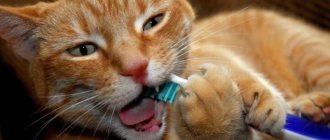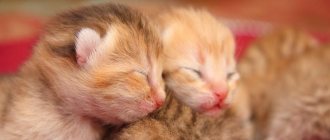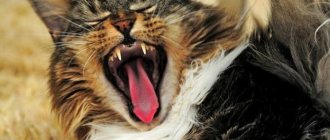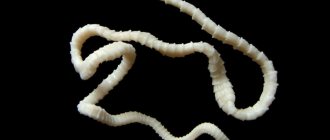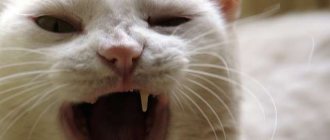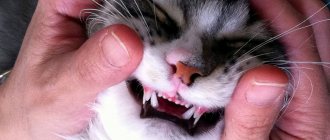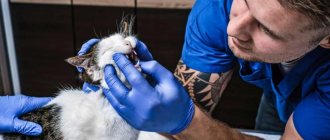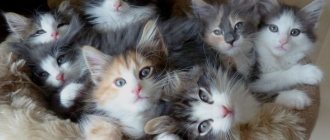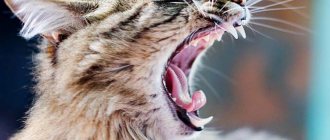To find out when kittens change their baby teeth to permanent ones, read the article. Here you will get detailed information about this issue.
It is noteworthy that small kittens, like children, are born without teeth. And over time, they grow milk teeth, which then tend to fall out and change to permanent ones. Of course, in cats, the process of growing baby teeth occurs faster than in humans, but animals also experience discomfort. Let's find out in detail how this process occurs in cats.
When do kittens change their baby teeth to permanent ones, and at what age?
Kittens begin to develop their first teeth at two weeks of age. When a kitten is two months old, it already has all its milk teeth (26 in total). After some time, when the kitten grows up, the milk teeth lose their relevance and begin to gradually fall out. The replacement of baby teeth occurs at three to five months. It all depends on what breed the cat is and its individual development.
Pet owners will be able to notice this process in any way. The cat will behave anxiously and its habits will change. Your task is to give your animal maximum attention. And if for some reason the baby tooth does not fall out, it will have to be removed so that the cat does not have problems in the future. By seven months, the process of changing baby teeth in young cats is usually completed. The pet becomes the owner of thirty permanent teeth.
At what age do permanent teeth grow in cats?
Changes in the well-being and behavior of kittens
Teeth germination is painless, but is accompanied by severe itching. The animal scratches its gums: gnaws on inedible objects, bites the owner’s fingers, rubs its muzzle with its paw on the edges of furniture.
At the same time, the following natural changes are noticed:
- A repulsive odor appears from the mouth, because inflammation cannot be avoided. It goes away a month after growth is complete.
- Salivation increases during play and feeding; this is a protective reaction against inflammation of the mucous membranes of the mouth.
- The site where the next tooth appears swells and recovers 1 – 2 days after eruption.
- The animal eats worse, but does not completely lose its appetite.
- Sometimes the temperature rises to 39.5℃, the kitten looks for a warm place and lies down under the blanket.
- Bleeding after prolapse does not exceed 3 minutes.
Milk and molar teeth emerge from different sockets, so often a new one emerges when the temporary one has not yet fallen out. This phenomenon does not require intervention if they do not touch each other, there are no signs of inflammation on the gums, and the period for replacing teeth has not yet passed. Animals are not vaccinated until their bite is formed: their immunity weakens and they become more vulnerable to infections.
This is interesting: Eliminate cat odor
Change of baby teeth in kittens and cats: signs, symptoms
Animals, like people, do not tolerate the process of changing baby teeth well. They are also concerned about the discomfort during this period. In addition, the following symptoms :
- Pets become lethargic and sometimes begin to get sick, because during this period their immune system becomes weak.
- Even during the change of teeth, sometimes a smell appears from the kitten’s mouth, which quickly disappears as the process progresses.
- Kittens begin to chew on all sorts of objects, and they can also bite your legs and arms. The main thing for you is to make sure that this does not subsequently become a habit of the animal. Otherwise, your cat will continue to bite your fingers, etc.
- Cats lose their teeth, you can find them on the floor or somewhere else in the room. If you are a caring owner, then pay attention to the cat’s oral cavity. It is necessary that there is no suppuration anywhere. If a painful area occurs, take your pet to the veterinarian. Oddly enough, animals can also suffer from dental problems.
Milk teeth fall out in cats and kittens
Kitten care
Electrical wires and objects that can be easily chewed and swallowed are removed from the pet’s access area. Felinologists advise stopping attempts to bite the hands of their owners; it will be difficult to wean an adult animal from this habit.
The pet’s condition can be alleviated by the following actions:
To reduce itching, give rubber toys from the pet store to chew on. Teethers with water inside will soothe your gums if you cool them in the freezer first. To prevent inflammation, the mouth is wiped daily with a gauze swab dipped in a solution of soda or a decoction of chamomile and sage.
Medicinal herbs are used carefully; they often cause allergies. Once every 2 months, the pet is taken to the clinic for preventive examinations; the doctor will monitor the formation of a normal bite and the timing of teething.
After 6 months, teeth are brushed twice a week with a soft-bristled brush or wiped with a silicone fingertip; they are bought in pet stores along with a special paste for animals.
They are accustomed to the new hygienic procedure gradually, cleaning with one movement from top to bottom from the outside and inside. When finished, wipe the gums with gauze soaked in clean warm water.
Which teeth fall out first in kittens?
The kitten's incisors will be the first to fall out. The process takes place in three to four months. If the kitten is not sick with anything and is well fed, then the change of teeth occurs normally, without any complications. Experts advise feeding animals meat (solid food), then they will not develop plaque on their teeth and, as a result, will not develop tartar.
Milk teeth in kittens
General information
A sign of a “full” mouth is the desire of babies to chew something, starting from their paws and ending with the owner’s feet. This period should be accompanied by the closest monitoring of the kittens, properly organized nutrition, and dental care.
By 1.5-2 months, kittens have a full milk set, consisting of incisors, canines and molars. There comes a transition from sucking to the chewing period. The peculiarity of the replacement teeth is their thinness and whiteness in comparison with the molars.
By 3-5 months, baby teeth are replaced by permanent ones; the owners, due to the painlessness of the process, do not notice this process. The formation of the dentition is completed by 7-8 months of age. The gums remain pink and smooth, without stones and deposits of a creamy white or milky tone.
When kittens change teeth, symptoms may appear: increased drooling, short sleep, refusal to eat, unpleasant odor. If they appear, you should consult a specialist.
At what months do kittens change their fangs?
Immediately behind the incisors, the fangs begin to fall out, in the place of which permanent, strong teeth begin to grow. At this time (when permanent teeth grow), vitamins and minerals will not hurt your furry baby. Thanks to them, your animal will tolerate changing teeth well and will not get sick. It is better not to do routine vaccinations during the growth of permanent teeth, due to the weakened immune system of the pet.
Don't worry if your kitten refuses to eat during this period. After all, sometimes teeth do not allow you to eat properly. But when a cat does not eat for more than one day, then the problems may be more serious than changing the baby fangs. In this case, visit a veterinarian. Let the doctor diagnose the animal.
When do fangs change?
Diet when changing teeth
Throughout the entire period of changing teeth, the kitten must eat properly. Food should be rich in calcium and phosphorus, which will ensure the growth of healthy and strong teeth. It will be very useful to enrich your pet’s diet with vitamins and minerals during the period when molars appear. It is best if the kitten’s diet includes the following products :
- fermented milk products, especially cottage cheese,
- lean meat: beef, rabbit, chicken, rabbit,
- vegetables – carrots, zucchini, pumpkin,
- cereals – buckwheat, rice, oatmeal.
Do fold-eared kittens lose teeth?
Recently, the Scottish Fold breed has gained particular popularity. These cats are very kind creatures, they love their owners, and they get along well with other pets in the apartment.
Kittens do not require special care and are not picky about their maintenance. They come in different colors: from gray-smoky to bright red. The fur of such cats is short, uniform, plush, so to speak.
The teeth of a purebred kitten, like those of ordinary cats, grow almost the same. Little fluffies are born without teeth. In a month or two they already become toothy, by which time they already have twenty-six milk teeth. At three to four months, baby teeth begin to fall out, and permanent teeth grow in place of those that have already fallen out. At seven months, the process of changing teeth ends.
Scottish kittens' teeth
Be attentive to your pets. If, during the loss of milk teeth, the kitten behaves differently than usual, meows often, and does not eat even the most delicious treats, then it has health problems. Maybe your gums are inflamed or there are other difficulties. Examine your pet after washing your hands. In case of severe inflammation of the gums, do not delay a visit to the veterinarian.
Why do new teeth emerge?
Just like in humans, kittens 4 months and older gradually replace their milky bone tissue with permanent teeth. Many owners get scared when they notice that the cat is missing one tooth or is constantly scratching its lips and gums. There is no need to worry, since such a process is completely natural and necessary. It is only important to ensure that the animal grows a new set of teeth normally and does not have double teeth, in which two teeth immediately fall out in place of one tooth. Contacting a veterinarian is also necessary in other cases:
- the resulting wounds fester and heal for a long time;
- inflammatory reaction in the gum area.
Bite formation
When kittens receive a sufficient amount of milk and balanced complementary foods, actively gain weight and do not get sick, their teeth fall out in a timely manner, and milk teeth do not delay the appearance of permanent ones.
In other situations, the process should be monitored in order to promptly detect deviations in its development.
Sometimes temporary teeth linger in the gums, interfering with the growth of permanent teeth, and new ones have to form to the side. Even molars can deviate in development if a primary premolar “stays too long” in the neighborhood.
This not only causes pain for the kitten and leads to inflammation of the mucous membranes and gums, but also affects the bite, which will remain for life.
In such cases, the pet will have to be taken to a veterinary dentist, who will help remove the old tooth. You should not pull out a loose fang or incisor yourself - you can cause pain to the baby and accidentally introduce an infection into the wound.
What pathologies can there be?
A deviation in the rate of tooth change causes the formation of a malocclusion, which can be of 2 types - undershot or overshot, which prevents the kitten from eating normally. And teeth that grow to the side will cling to the inner surface of the cheeks and injure the skin, which will lead to inflammatory processes.
Non-standardly formed dentition causes jaw misalignment. And this is not just a cosmetic defect: in the future the animal will not be able to fully chew solid food, and the soft tissues in the mouth will be constantly injured.
They stand out from each other in their shapes.
Functional Features
| View | Purpose |
| Incisors | They are located in the center of the dentition, between the fangs. Their function is to capture and cut food. The kitten uses these same teeth when grooming its fur. |
| Fangs | Cats are hunters by nature; they must securely hold food in their teeth, which they successfully do using their fangs. Another important function is protective. Cats use these teeth when confronting an enemy. |
| Premolars and molars | Participate in retaining and transporting prey. The root system also bears the main burden when chewing and grinding food. |
